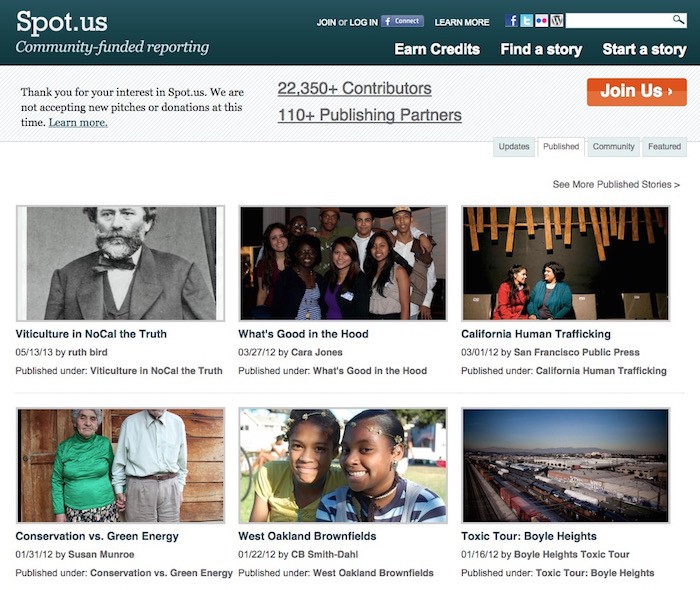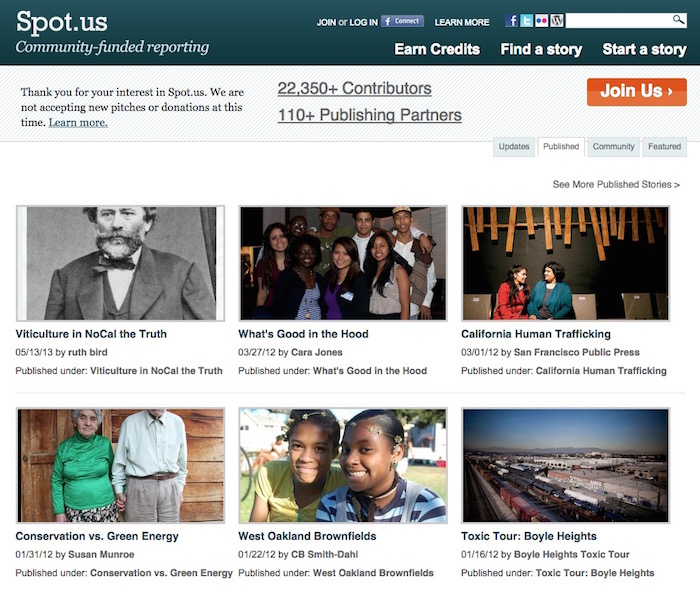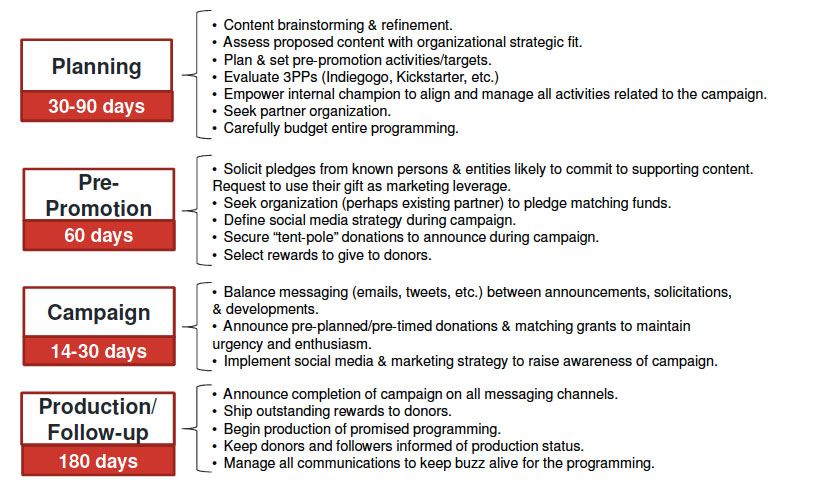
Editor’s note: Spot.us, funded in the second ever Knight News Challenge back in 2008, was an early innovator in crowdfunding journalism. Think Kickstarter before Kickstarter. But despite its early start, it seemed to lose momentum, with projects growing fewer in number.
In 2011, it was acquired by American Public Media, which wasn’t quite sure what to do with it. APM did an evaluation that tried to better understand the crowdfunding-for-journalism world in 2015. This, written by APM’s Joellen Easton, is the fruit of that process, which injects numbers and analysis into what sometimes has been an airy discussion.
A year ago, American Public Media decided to place the crowdfunding site Spot.us on hiatus and conduct an assessment of the platform and its potential. We completed that evaluation in the spring, took a few months to digest what we learned, and decided to sunset Spot.us effective today.
The things that didn’t work about Spot.us’ back end were significant, and it would not be possible to scale the platform or improve the user experience without completely overhauling the code base. Doing this would be expensive, and given the other crowdfunding options that are available to journalists today — both general interest and journalism-specific — it became clear that we could not offer a fundable service that would benefit audiences, journalists or public interest media more than what already exists.

Our analysis also showed:
Spot.us proved that crowdfunding can help support independent, local journalism, especially that of freelancers. It was an important early innovator in the field, and many of the platforms available in 2015 owe a lot to founder David Cohn and the community of Spot.us users. (We are archiving the code and the stories that make up Spot.us, so the world won’t lose them.)
Its legacy also includes a large body of research, including the Spot.us assessment we commissioned from Carlson Ventures Enterprise (CVE) at the University of Minnesota’s Carlson School of Management.
As Cohn so often said, Spot.us “was an experiment in pushing the boundaries of transparency and participation in the process of journalism.” And it is in that spirit that we would like to share with you some of CVE’s other findings, specifically those that will help to write a new chapter in the crowdfunding playbook.
Kickstarter boasts 7.9 million users, including 2.3 million who have backed more than one project. Indiegogo, meanwhile, touts 15 million monthly visitors. (Donor stats were not immediately available.)
These large-scale platforms introduce users to projects via genre recommendations, making it possible for you to reach new audiences with an affinity for the kind of content you are making, even if they’ve never heard of you before.
In 2012 and again in 2014, Austin’s public television station KLRU used Indiegogo to raise money for its educational “BBQ with Franklin” web series featuring Austin BBQ master Aaron Franklin. The first campaign attracted 241 donors and helped grow the station’s YouTube channel to 32,000 subscribers. The second campaign met its $20,000 goal in just three weeks and inspired a dramatic jump in views to the show’s YouTube channel.

Weekly views of KLRU YouTube channel before and after launch of second BBQ campaign. Image courtesy of KLRU.
Sara Robertson, KLRU’s vice president for production and technology, said the first campaign helped prove that there was an audience and a community ready to support the series, something that was critical to getting the attention of major TV underwriters.
It helped to have a BBQ celebrity whose advice is widely valued, Robertson added. But viewers also appreciate — and regularly comment on — the relevance and helpful nature of the videos. “They teach their sons how to [make BBQ], using the videos. To me, that is the purpose of public media: to provide educational, great content that betters families.” The series is available on KLRU.org and is coming soon to TV.
Crowdfunding does not cannibalize donors, a concern of crowdfunding critics. Instead, it segments them, according to Gabe Bullard, director of news and editorial strategy at WFPL in Louisville, Ky.
WFPL ran a successful campaign on Kickstarter in spring 2013 for “Unbound,” a new program focused on short works of fiction. The station slightly exceeded its $4,000 goal with contributions from 150 backers. For the 70 backers who were already members of the station, the Kickstarter donation was an additional gift and didn’t reduce subsequent gifts.
But WFPL only was able to convert three of the new donors into members.
“They just fell off our radar because they were such a small group, and we had all these larger groups we were managing,” said WFPL membership manager Kelly Wilkinson. The lesson? “Get the fundraising team involved early on in the process, so that things run smoothly.”
That’s what KLRU did with its “BBQ with Franklin” campaign. In fact, the station treated all of its crowdfunding backers as members, inviting them to events (especially to anything BBQ-related), to receive station newsletters, and to connect on social media.
“Success at this fundraising method requires a shift away from thinking about crowdfunding as simply a gathering of small gifts. It’s more akin to joining and building a cohesive funding community,” explains public media consultant Richard McPherson in a 2013 commentary on Current.org.
Observing Radiotopia’s recent successful Kickstarter campaign, Josh Stearns of LocalNewsLab.org agrees: “Throughout the [Radiotopia] campaign there was an intentional and ongoing recruitment effort to keep people engaged not just as donors but as part of the team.”
Of the 241 people who backed KLRU’s 2012 “BBQ with Franklin” campaign, all but eight were not current members. Twenty-five percent of those donors stuck around as members (including 10 as major donors) for more than one year, and 20 percent are still active today.
According to KLRU membership director Susannah Winslow, their success has made KLRU “stop and think about being more strategic about how we touch our prospective donors,” and that crowdfunding creates “more of a connection to the production and then to the station, whereas pledge is a transaction.”
Again and again, we’ve heard from stations (and our own internal producers, too) that they want a playbook for public media crowdfunding. This blog post and anything I’ve linked to should help you start to get an understanding of what works. We can also offer you a timeline and checklist of what to do when in order to conduct a well-run and well-organized campaign. This timeline was created by the CVE team working with us, and informed by interviews with staffers from nine public media organizations.
First, you should be able to answer YES to at least two of these questions:
Next, make sure you give yourself enough time before and after the campaign. It’s smart to break up the project into four segments of work, which can potentially comprise a year-long project:

Planning (allot 30-90 days)
Pre-promotion (allot 60 days)

Campaign (plan for 14-30 days)
Production/followup (expect up to 180 days)
Also published at the Public Insight Network.